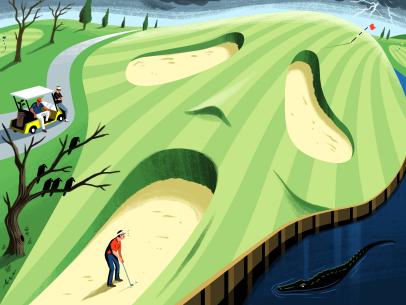This article first appeared in Low Net, a Golf Digest+ exclusive newsletter written for the average golfer, by an average golfer. To get Low Net straight to your inbox, subscribe here. Have a topic you want me to explore? Send me an email at Samuel.Weinman@wbd.com.
As complaints go, “I played too much on a recent golf trip” is the kind that invites death stares from colleagues and members of your immediate family. No one has much sympathy for a golfer who has run himself ragged packing too many swings into too short a window, no matter how much Advil I needed along the way.
The best way to encapsulate my recent trip to Bandon Dunes as part of the resort’s 25th anniversary celebration is that I was sharp enough on the first hole of the week to tap in for par, and wobbly enough by the last that my ball was in my pocket. The intervening 100 or so holes featured my usual mix of encouraging, passable and laughably inept. It was everything a golf sicko like me could want, save for the increased frequency of bad swings by the end.
The inevitable conclusion is that golf in excess has diminishing returns. We all like to say our games need more reps to turn a corner, but is it possible too many reps turn us back in the direction of our worst habits?
This was the question I presented to Golf Digest Top 50 teacher Michael Breed when I returned home from Bandon. In a curious way, I was happy to hear him disagree.
“It’s not too much golf,” Breed corrected me. “It’s the lack of preparation.”
In detailing for Breed the ways my golf swing faltered over the course of the trip, the teacher said I was focusing on the wrong problem. My swing didn’t “leave me,” as I originally suggested. It was all the supporting infrastructure—my posture, my grip pressure, my alignment—that was really lost instead.
“Your golf swing doesn't erode,” he said. “Your body and mind erodes, and as a result, the motion you make with a given club isn’t great.”
This might seem like semantics, but the distinction is in recognizing the essential role preparation plays before packing your bags. One of the great misconceptions about golfers and working out is it’s done primarily in the service of hitting the ball further. Sure, it helps that, too. But even Tiger Woods said much of his training was about maintaining the same level of focus and intensity over 18 and then 72 holes. “If you’re playing baseball or running track or cross country, if you’re not training, you’re not going to be able to keep up. I brought that same mentality to the game of golf,” Woods told Golf Digest in 2019.
When it comes to average golfers who usually max out at a couple of rounds a week, it makes sense you’d need to adjust if you want to play more. Much of this was spelled out by Golf Digest’s Ron Kaspriske in a survival guide to buddies trips we published last year, which outlines preemptive measures like massage therapy, mobility exercises, rest and nutrition. Applied strategically, it’s a recipe for finishing a golf trip strong and not staggering home.
Speaking of poor preparation, I wish I remembered to review Ron’s advice before my trip, instead of after I got back.



